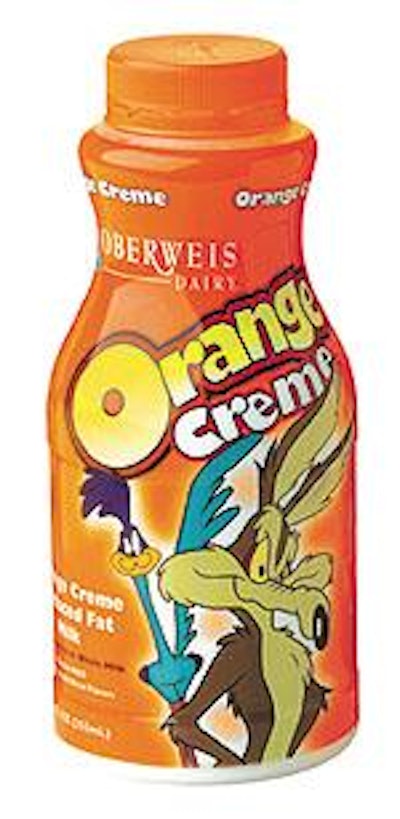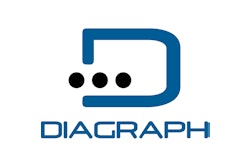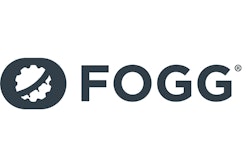Oberweis Dairy sees so much potential in its single-serve, plastic-bottled milk and dairy beverages that it’s invested upwards of $1 million on a new filling line at its North Aurora, IL, headquarters/
manufacturing facility.
The 100-bpm line is equipped with new filling, capping, labeling, conveying, bottle-packing, and shrink-wrapping machinery. Currently, the line runs about four to five hours, four days a week, as Oberweis rolls out the new 12-oz bottles.
Oberweis recognizes that the more frequently the new line runs, the quicker its return on investment. “We justify the investment in a number of ways,” says Mark Leonardelli, vice president of sales and marketing for the dairy. “First, we know [the ability to fill these bottles is] important to our future, whether it’s for the Looney Tunes flavored milks (see sidebar, p. 50), our own single-serve products, or other products we’re considering.”
Equipment purchase decisions were made based primarily on the package and limited plant space. “You start with knowing your line footprint,” suggests Mark Kloster, plant manager at the North Aurora facility. The line’s dimensions, he estimates, measure 20’ x 30’. “We knew there would be other machines that would work for our application, but not all of them would work in this limited space.” The new line is tightly positioned between a ½-gal glass container filling line and an ice cream filling line.
While space considerations were important, the materials played a critical role in determining what packaging machinery to purchase. “Without a doubt, the materials dictated what equipment we bought,” Kloster recalls.
“We wanted to use a particular bottle and a full-sleeve label,” he continues. “We worked with a general contractor that was very instrumental in the line layout, and the contractor recommended equipment vendors familiar with the dairy industry.”
Kloster credits that contractor, W. M. Sprinkman Corp. (Franksville, WI), with serving as the system integrator for the line. Sprinkman also recommended tabletop and cable conveyors from Concept Systems (Grand Rapids, MI).
Filling and capping
Oberweis uses a semi-automatic machine to debag the clean PET bottles from the plastic bundles in which QDC Plastic Container Co. (Lansing, MI) ships them to the dairy. Bundles are conveyed past a knife that cuts off one end of the bag. Bottles are manually placed onto a hooded and enclosed cable conveyor that carries them several hundred feet, just beneath the ceiling, through an opening in a wall, then down a decline about 10’ to the filling line.
Bottles are conveyed through a feedscrew that times their release into an infeed starwheel that transfers them into the FG-185 monobloc filling and capping station from Fogg Filler (Holland, MI). The starwheel delivers bottles onto lift pedestals on the 18-valve rotary filling turret.
Once filled, bottles are conveyed through a transfer starwheel that delivers them to a five-station rotary roll-snap capper. The Fogg capper applies the caps as bottles ascend on a cam. Capped bottles descend and are discharged through a starwheel. Then an ink-jet coder prints a code onto the cap. The coder, from Diagraph (St. Louis, MO), provides an 18-day code from date of manufacture.
Labeling
Coded bottles are conveyed downstream through an area described as an “air knife” by Kloster. The air knife includes two tubes, one mounted along each side of the conveyor. Each tube is about 5’ long. As bottles are conveyed between the tubes, air is blown from the tubes toward the bottles.
This removes condensation that forms on bottle surfaces when bottles, filled at temperatures below 40°F, come in contact with the warmer room air. By removing condensation, shrink-sleeve labels adhere properly to the bottle.
Bottles pass the air knife station and proceed through a paddle wheel device that spaces them properly for downstream sleeve-label application. The extra space between bottles is important because the label dropped onto the bottle is wider than the bottle. If bottles were placed too closely, the labels could interfere with the process. The paddle wheel device, as well as the EZ-2-200 dual-head label application system, is supplied by Axon (Raleigh, NC).
Each head uses a roll of film that’s preprinted, folded and sealed into a tube. The flat film tube opens around a mandrel, then is delivered downward toward the conveyor below that carries the bottles.
A knife cuts the material and the open sleeve label drops over the bottle. The bottle then passes two preshrinking devices, one on each side of the conveyor. Also made by Axon, the devices direct hot air along a narrow band at the base of the container. This shrinks the label in place as it enters an Axon EZ-72-SS shrink tunnel that uses steam to shrink the full-body label into place on the bottle.
“My understanding is that steam does a better overall job of shrinking than hot air,” says Kloster. “The problem with hot air is that it doesn’t surround the bottle well enough to deliver a good, consistent shrink of the label.”
Downstream duo
Shrink-labeled bottles are conveyed through a wall opening to a Model 90 Spot-Pak® bottle packaging system from Delkor Systems (Minneapolis, MN). The machine uses a cross-push arm to push bottles toward a staging area. It does so in three rows of four bottles.
The 12 bottles are held in place by a metal stop gate. Once the 12 are assembled, the gate opens, releasing the bottle group into a pickup area where a vacuum head lifts them up a few inches.
A pick-and-place module, positioned at a right angle to the pickup area, pushes a corrugated pad along a conveyor into the pickup area. Just before the pad reaches this area, nozzles deliver three strips of removable hot melt adhesive to the pad. The pad is pushed into the pickup area before the pneumatic-powered head lowers the bottles onto the pad.
The hot melt temporarily holds bottles in place on the pad as they’re conveyed a few feet to a Delkor Model 112 wrapper and heat tunnel. The pack is pushed into a 2-mil low-density polyethylene film curtain that envelops the bottles, and then seals and cuts the film. The film-bundled pack is then sent into the shrink tunnel. The multipacks are palletized by hand, and pallet loads are shipped to Oberweis stores or to retail customers.
Based on the initial success of the dairy’s single-serve bottles, Oberweis’s investment of more than $1 million for the new filling line is beginning to reap dividends.





























